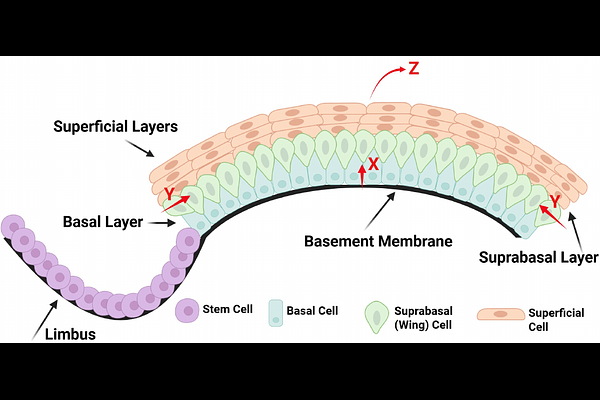Intercellular forces driving stratification in a two-layer corneal epithelium: Insight from a Voronoi cell-based simulation model

Intercellular forces driving stratification in a two-layer corneal epithelium: Insight from a Voronoi cell-based simulation model
Khodabakhsh Joniani, N.; Martinez-Martin, D.; Kim, P. S.; Lyons, J. G.
AbstractThe cornea is a self-renewing, multilayered tissue maintained with remarkable precision. Its outermost layer, the corneal epithelium, consists of five to seven stratified cell layers, sustained by two coordinated processes: the centripetal migration of transit amplifying cells (TACs) from peripheral limbal epithelial stem cells (LESCs), and delamination (vertical movement) of cells between layers. Despite this well-organized renewal, the mechanisms governing epithelial stratification remain largely unknown. In this study, we present a two-dimensional Voronoi cell-based model that captures the dynamics of epithelial stratification. Our model incorporates two distinct epithelial layers--the basal and the suprabasal layers--and accounts for key cellular processes. These processes are mediated by mechanical interactions such as cell-substrate adhesion, as well as horizontal and vertical intercellular forces. Our simulations show that cell delamination, which drives stratification, is strongly linked to TAC proliferation. In contrast, LESC division remains largely unchanged, suggesting that TACs buffer LESC activity, consistent with the slow-cycling nature of stem cells. This reveals that processes weakening the cell-to-substrate interaction will enhance the turnover of epithelial cells without the need for external growth factor induction, which is a notable finding. Interestingly, although increased shedding promotes division and delamination, excessive shedding leads to mechanical compensation via cell stretching in the upper layers. This mechanical response explains the presence of enlarged cells in the superficial layers of the corneal epithelium. Our model reveals a direct link between the shedding rate and the centripetal velocity of clonal growth, predicting that increased surface cell loss accelerates cell movement-a response similar to wound healing, where cells rapidly migrate to restore the damaged area. These results highlight how cell size, migration, and turnover are tightly coupled, and offer deeper insights into how physical forces work together to maintain and rapidly restore epithelial integrity.